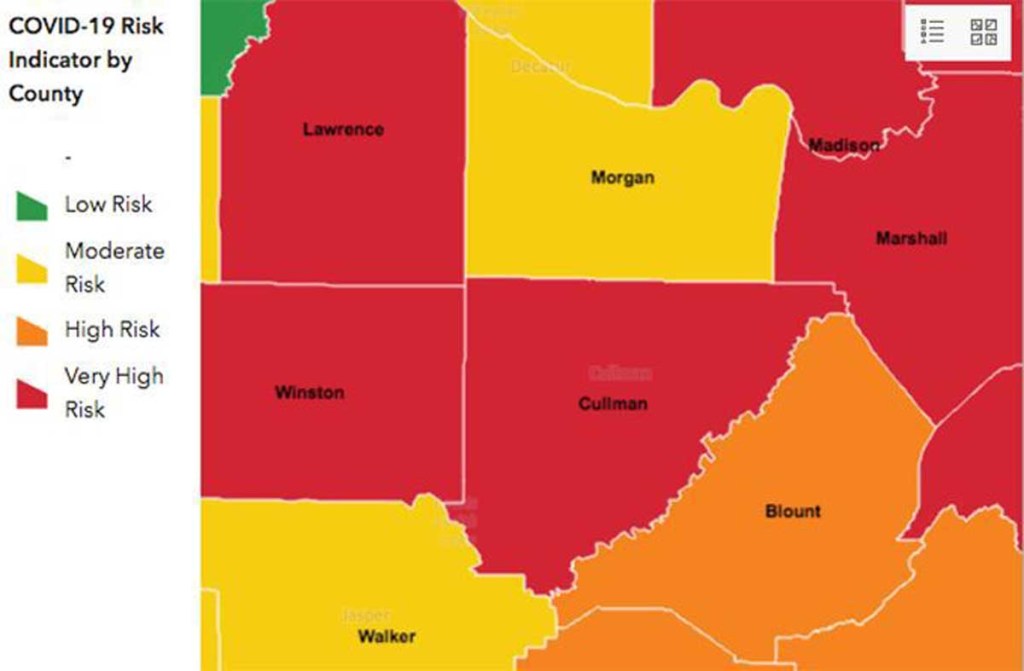Cullman County categorized as ‘very high risk’ on COVID-19 dashboard
Published 8:46 pm Tuesday, June 30, 2020

- Cullman County is in the “very high risk” level according to a new dashboard unveiled by the Alabama Department of Public Health (ADPH) Tuesday.
Cullman County is in the “very high risk” level according to a new dashboard unveiled by the Alabama Department of Public Health (ADPH) Tuesday. In a statement, ADPH said the new tool “allows policy makers and others viewing it to recognize the COVID-19 risk status in each county and to guide health behavior.” The new COVID-19 Risk Indicator Dashboard is located on the ADPH website at alabamapublichealth.gov.
As of Tuesday, Cullman County had 398 confirmed cases, 10 probable and 3 confirmed deaths. Also, on Tuesday, Cullman Regional reported one patient on a ventilator.
COVID-19 data has been collected since March 6 when State Health Officer Dr. Scott Harris issued an emergency order declaring COVID-19 reportable, which means that individuals and entities known as required reporters must notify ADPH within a specified timeframe of any case of COVID-19, and laboratories must report all negative and positive SARS-CoV-2 test results. Required reporters include healthcare providers, healthcare facility administrators and medical examiners.
Calculation for each county’s risk of COVID-19 spread in the community is based on the increasing or decreasing trend in the number of new cases each day. The number of new cases each day is determined with a rolling three-day average to account for fluctuations in reporting. The main indicator for decreasing risk of COVID-19 spread in the community is the number of days the county has experienced a downward trend of new cases. Several factors can influence a county’s number of new COVID-19 cases, so other factors are examined to additionally inform the level of a county. A detailed explanation of how the overall risk level is determined is located on the COVID-19 Risk Indicator Dashboard.
A color-coded state map displays four risk levels: very high, high, moderate and low indicated in red, orange, yellow and green, respectively. When a county is shown in green, it does not mean the public should resume their pre-pandemic activities; the green color just indicates a lower comparative risk in this ongoing process.
“We are committed to protecting the health and safety of Alabamians by giving guidance based on the best science and public health practices available,” State Health Officer Dr. Scott Harris said. “We will continue to maintain and update the statewide data and metrics and provide consistent localized data for use in local decision-making for reopening plans.”
ADPH flyers describe actions that should be taken depending on risk level, and each phase has several guidelines in common which are needed regardless of risk phase. These are social distancing of 6 feet in public settings, wearing cloth face coverings (when social distancing is difficult to maintain), and proper hand hygiene. In addition to general guidelines, recommendations are also provided for high-risk individuals and children.
People at high risk are encouraged to operate under stricter adherence because they are more likely to suffer severe illness from COVID-19. Those at high-risk include people 65 years old or older and people with heart disease, diabetes, other chronic diseases or weakened immune systems. These people should exercise extreme caution, use face coverings when around people outside their households, and take other measures such as staying at least 6 feet from people outside their households. People who work or live with high-risk people should also continue following extra precautions to reduce their chances of getting the virus, regardless of phase.
These are the recommendations for Cullman County residents based on the “very high risk” classification:
- Wear face coverings where other social distancing measures are difficult to maintain.
- Even when visiting family or friends, wear face coverings when within 6 feet of people outside your household.
- Avoid all unnecessary travel. If you must travel, avoid crowded areas if possible.
- Telework if possible. If not, maintain a 6-foot distance from others and wear face coverings at work.
- Takeout, pickup or delivery from restaurants is strongly encouraged rather than dining in.
- Avoid groups of more than 20 people.
- Avoid unnecessary visits to hospitals, nursing homes or other residential care facilities.
- Worship online or keep 6-foot distances between people of different households.
- Children with COVID-19 should stay home or be sent home for school or child care if showing symptoms. Limit public interaction between children and do not allow children on public playgrounds.
Additional COVID-19 information can be found at alabamapublichealth.gov.





